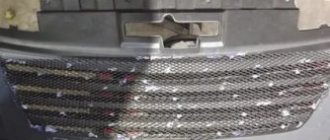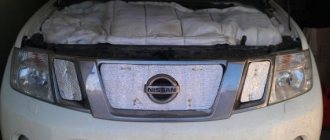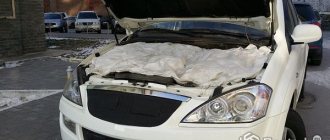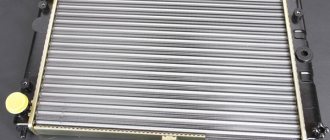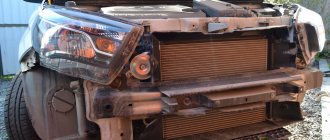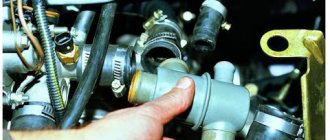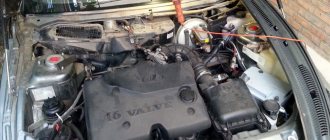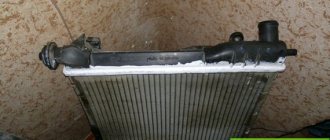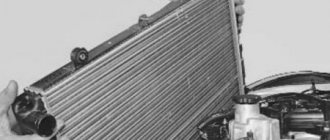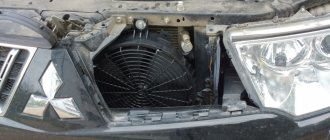Starting a car engine in winter is half the battle, but keeping the cabin warm is a more difficult question. If in your car the process of warming up the interior takes a long time, then you can install a coolant heater in the system. This operation is quite expensive, which is why it is not very popular.
If you don’t know how you can retain heat in the cooling system longer, then we will tell you about such an interesting method - “radiator insulation”. There are many myths around this method, and no one has tested the benefits of the method experimentally. That is why in this article we will look at why you need to insulate a radiator, as well as how to do it correctly.
Is it necessary to close the radiator grille in winter?
Those people who are ardent opponents of all cardboard and other insulation materials believe that if the regulator in the car works properly, then there is no need to wrap the radiator. And indeed, this is so, because the liquid circulates in a small circle, completely bypassing the radiator, which is why there is no need for insulation. But if the movement of the coolant is transferred to a large circle, then there is a need to insulate the radiator grille.
The fact is that only by insulating the radiator will it be possible to maintain a stable operating temperature of the engine. And this, in turn, will have a beneficial effect on the operation of the engine, because it will wear out significantly less.
Attention!
It is necessary to insulate the radiator when the air temperature outside reaches -10º C - not earlier!
How modern cooling systems work
Currently, liquid systems of a closed sealed type with forced circulation of non-freezing liquid (antifreeze) are used.
The system includes several main components:
- cooling jackets for the block and cylinder head;
- main radiator for heat exchange with outside air;
- interior heating radiator;
- thermostat that redistributes liquid flows;
- radiator forced air fan;
- antifreeze expansion tank and plug with a pressure relief valve;
- water pump (pump).
There are three main operating modes of the system:
- standard temperature control controlled by a thermostat;
- forcing the radiator to flow with a connected fan after the temperature exceeds a certain critical threshold;
- emergency pressure release, when the system can no longer cope, the temperature rises uncontrollably, and system elements may be damaged.
While the engine is warming up, the thermostat closes the radiator channel, circulation occurs in a small circle, and the liquid is returned to the jackets by a pump without additional cooling. When the optimal thermal regime is reached, the thermostat opens slightly, part of the antifreeze goes into the radiator, where it reduces its temperature.
Theoretical knowledge
It is better to learn how to properly install insulation from experienced drivers who have been driving for several years. There is nothing difficult in this operation, but still, the advice of experienced craftsmen will definitely not be superfluous. You should be interested in why this is necessary at all only after mastering this insulation technology. Making the right decision and the chosen insulation method makes it possible to evaluate all the advantages and benefits of engine insulation.
If you restrict the air flow to the grille, you will receive the following benefits:
- When driving at high speeds, heat will remain in the engine compartment.
- The desired coolant temperature is quickly reached, the engine quickly reaches a sufficient temperature, and this will warm up the air in the car’s interior faster.
- Even when driving short distances, the engine will warm up faster.
Insulation for a car
- 99 0 87k
- 3 0 2k
Insulation for a car allows you to retain heat in the engine, its cooling system and the battery. Thanks to insulation, the car owner can quickly warm up the engine in cold weather (while saving fuel), heat the interior, and get rid of ice on the hood. However, car insulation also has disadvantages. Among them are the possibility of overheating, a drop in motor power, and the possibility of fire of a low-quality product. The low service life of most of these “blankets” (about one to two years), coupled with their fairly high cost, frustrate car owners even more.
Practical significance
Premium cars are equipped with special dampers; they make it possible to regulate the flow of air that will blow over the engine. If the engine reaches a constant operating temperature in a short time, the condition of the engine elements will be maintained in good condition. That is why there are so many ways to close the radiator, because it is really worth it, as it reduces engine wear.
Car radiator insulation
If the air circulates under the hood on its own, then this will only be a plus, and here’s why:
- Fuel consumption will be significantly reduced, and the thing is that when the engine is cold, the electronic control unit directs a supersaturated fuel mixture into the cylinders.
- Once the additional air flow through the radiator grille stops, the engine will warm up faster and the air in the cabin will also warm up faster. Basically, many motorists insulate the radiator for this very reason, so the air in the cabin will warm up several times faster.
You can especially notice changes when the temperature outside drops below 20-25 degrees Celsius. In this case, the climate in the cabin will become favorable in a short time, and at idle speed. This is confirmed by owners of both carburetor and injection cars.
Homemade radiator insulation on a car
Sometimes owners simply purchase an additional heater that will be powered from the cigarette lighter. But another part of motorists does not see the point in additional expenses, because they can simply insulate the radiator.
Car heater inside the cabin
Protecting the simplest systems
Cars that are not equipped with modern sensors have a particular need to keep warm. During engine operation, it is cooled by a fan and counter-air flow. In low temperature conditions during warm-up, the fan creates additional difficulties by cooling the motor when there is no need for it. While driving, the higher the crankshaft speed, the faster the car moves. If the ambient temperature is 25 degrees or lower, then there is too much flow of oncoming cold air, which does not allow maintaining the desired temperature.
To eliminate such factors, cardboard is used.
Its installation provides the following advantages:
- The engine warms up much faster. This is especially important for short-term movements.
- While driving, the temperature quickly reaches its optimal level.
- Excessive cold flow is retained when the car accelerates at high speed.
Using the damper allows you to reduce fuel consumption by reducing the time it takes to warm up the engine. While driving on the highway, the interior is heated better.
Myths about insulating the radiator grille
Many companies try so hard to promote their radiator insulation products that they come up with non-existent benefits from insulation or elevate this benefit to an absolute, greatly exaggerating it. Such tricks often work, and car owners buy such products without hesitation.
Car blanket insulation
We decided to tell you about certain myths, so that in the future you can think about and evaluate whether insulation is really such a benefit, and whether you specifically need it. Here are a few arguments that manufacturers use:
- Fuel savings up to 30%.
- The battery will hold its charge much longer.
- Makes it easier to start the engine when the engine is cold.
As you might have guessed, some criteria are greatly exaggerated, and insulation has virtually no effect on the ease of starting, because during a frosty night the internal combustion engine still manages to freeze very much - even the most heat-retaining material will not be able to retain heat in winter for more than 5-6 hours. The insulation doesn’t really help the battery either, because the crankshaft still has to be turned in thick oil. That is why we urge you not to fall for such tricks and to sensibly evaluate the advantages and disadvantages of such products.
Insulated engine and radiator grille
Thus, radiator insulation helps and facilitates some aspects of the car’s operation, but is not a panacea. It will help save fuel, the engine will warm up faster in the cold, the car will become warmer, but this does not mean that the internal systems of the car will be maintained at room temperature around the clock.
Why insulate your car?
We met and started reloading the tires. While unloading, I noticed that his car was already prepared for winter. Not surprising, because winter in my region is quite harsh. Think about it, just one attempt at cold starting is equivalent to a week of summer operation of the car.
And the fewer such starts there are, the better it will be for the engine. That is why many drivers try to insulate their car in advance.
I asked myself this question, but I still didn’t have any free time. And Dima himself insulated the car, so I decided to consult with him.
Which areas of the engine compartment can be insulated:
- hood;
- engine shield, to a lesser extent - side body panels;
- area in front of the cooling radiator;
- bottom of the engine compartment.
It is necessary to insulate all areas only if the car is used for a long time in conditions far beyond -30ºС. But even in this case, the radiator insulation must be removable, and the fan switch sensor and coolant temperature indicator must be in working order.
For less severe climatic conditions, it is enough to insulate the hood and the bottom of the engine compartment. Radiator insulation is also relevant, but in any case it should be quick-removable. If for small-volume diesel internal combustion engines this factor is not so significant, then large-volume gasoline internal combustion engines can overheat during prolonged driving.
Insulating the radiator grille: pros and cons
The main advantage of using radiator insulation is that the engine requires less fuel to reach operating temperature. This means that you can not only warm up the car faster, but thus save fuel. Also, the advantage is that road reagents will not get on the grille, and then it will not be destroyed by corrosion.
The disadvantage of radiator insulation can be considered, in a sense, the unaesthetic appearance of the car (the subjective opinion of some car owners). So, in some cases - when using hard protective covers - the radiator grille will be covered with black plastic, which somewhat reduces the appearance of the car; in other cases - when making insulation with your own hands - the grid may look a little “collective farm”: the translucent foiled side of the insulation, materials held on by clamps, unevenly cut cardboard, etc. In this case, in principle, everything depends solely on the straightforwardness and imagination of the car owner.
Homemade radiator (and engine) insulation
Another disadvantage may be an increased fire hazard if the insulation is installed inside the engine compartment. In this way, you can hide the external ugliness of the insulation material, but increase the chances of it catching fire. Still, during operation, some parts of the car reach quite high temperatures, and if something goes wrong, a spark will appear, some insulating materials may catch fire, this should not happen on the radiator side, but you should still be careful and attentive.
Cardboard radiator insulation
Insulation yourself
The easiest option is to insert pieces of cardboard between the grille and the radiator. This allows you to slightly reduce heat loss when traveling in winter. But this is not very effective. Besides, it's not very aesthetically pleasing. Therefore, it is best to use more modern insulation methods. Please note that working with radiator insulation is not enough.
You should also pay attention to the entire engine and engine compartment. When installing, be sure to securely fasten the insulation correctly. If it accidentally gets under the generator or timing belts, you will have to make expensive repairs to these systems.
The importance of additional engine insulation
As can be seen in the photo of engine insulation, such an event means the installation of additional thermal insulation.
A nice bonus in some cases is improved sound insulation. There are also advantages:
- slower engine cooling and faster reaching operating temperature;
- increasing the level of comfort when using the machine in the winter months.
Peculiarities
Today on sale you can find special car blankets designed to insulate the engine compartment of a car.
Insulating the engine with your own hands using them is quite simple. Even a beginner can handle the procedure. If you don’t want to spend money, then you can use improvised means for this purpose.
The global market amazes with the range of thermal insulation for cars. Modern insulation can not only protect the engine, but also reduce fuel consumption.
But not all drivers are confident in the need for such work. Many consider them a waste of time and money.
In reality, it is up to you whether to carry out additional thermal insulation measures or not. In any case, you will have to make one of the following decisions:
- equip the car with autostart;
- use an engine preheater.
Thanks to such mechanisms, time is saved after a long period of inactivity in frosty weather - you get behind the wheel in a warmed-up interior.
But it is worth noting their rather high price. In addition, the automatic start system requires high fuel consumption, and the preheater will significantly reduce the durability of the battery.
Types of car blankets
Based on the material of manufacture, such products are:
- Felt. Advantage - low thermal conductivity, disadvantage - insufficient fire safety.
- Fiberglass. Advantages - financial accessibility, low heat conductivity.
- From mullite-siliceous materials. Pros: frost resistance, resistance to aggressive chemicals and temperature changes.
On the outside, the types of thermal insulation described above are covered with durable and strong non-flammable fabric that can withstand high temperatures.
The following option is also possible - the presence of a mirror film on car blankets designed to reflect heat.
Specifics of the engine insulation process
After you have decided how to insulate the VAZ engine, you need to install a car blanket. The event is simple. No knowledge or special effort is required from you.
Car insulation will pay for itself within 1 – 2 months. With its help, heat will be retained, allowing the engine to reach operating temperature.
In addition, blankets for cars are non-toxic, fireproof, resistant to all liquids used in the vehicle, and are easy to install and subsequently maintain.
When purchasing car insulation, ask the seller and carefully study the product passport and certificate of conformity.
Before paying for your purchase, check the integrity of the packaging. In addition, the package must be branded. The shelf life of the car blanket is one season.
Nuances of insulation of diesel engines
There shouldn’t be any special problems with how to properly insulate the engine for the winter with your own hands. It is enough to purchase the necessary materials and use them in accordance with their intended purpose.
At the same time, it would be fair to say that a diesel engine is more sensitive to low temperatures than a gasoline engine. This is due to increased requirements for the quality of lubricant and the characteristics of diesel fuel.
Therefore, doing the insulation of the hood and engine of a car with your own hands if you have a diesel engine should be done with special care. In this regard, experts give several recommendations:
- Take advantage of a high-quality and effective car blanket that fits the specific dimensions of your engine compartment. If the frost is severe, but the blanket only partially covers the internal combustion engine, this will not have any effect.
- The car blanket itself only partially solves the problem of motor oil solidifying. Therefore, it is almost pointless to use only it when it is -30 degrees outside.
- Additionally, insulation of the pipelines that lead from the fuel tank to the engine itself is required. For these purposes, it is effective to use foamed polyethylene with a thickness of 5 mm.
- The same material should be used to cover various cracks under the hood.
- It would be a good idea to insulate the radiator using suitable materials. The same sheets that were used to process the hood cover will also work.
A distinctive feature of diesel is that it is in greater need of comprehensive insulation. Gasoline analogs are simpler in this component.
How to insulate gasoline internal combustion engines
Now let’s talk about how to properly insulate the hood and engine of a gasoline car with your own hands.
The technology here is similar. But gasoline internal combustion engines are hotter, they do not need special winter fuel, and therefore there is no need to cover the pipelines with protective materials.
In this case, the insulation of the engine and other components of the car is carried out according to the standard scheme. Namely:
- Insulation is being installed for the engine to survive the winter. It’s important to do this yourself when the temperature outside is consistently below -20 degrees Celsius, and at night can reach -30-40 degrees. If the winter is much warmer, such events will be unnecessary. Excessive insulation can only provoke overheating, and the engine will fail.
- A more reasonable solution, which will complement the car blanket in severe winters or act as an independent way to solve the problem in moderate frosts, would be to insulate the hood lid. Any of the materials listed above are used. Just choose the thickness and cut the workpieces so that the insulator does not come into contact with the battery terminals.
- In a really harsh winter, you can supplement the listed procedures by additionally laying an insulator to protect the engine. It needs to be dismantled, cleaned and dried, and then the adhesive insulation is cut out according to the template.
Additionally, on gasoline and diesel cars the radiator grille is closed. This point can also be debated endlessly.
Excessive insulation, even in winter, can lead to dangerous overheating, so it is important to use moderation and not get carried away with insulators.
Remember that the engine needs fresh air. If all channels are blocked, the cooling system may not cope during long driving. Yes, the engine will not cool down when parked for several hours, but a lack of cooling will have the opposite effect.
How and when to close the radiator grille
Insulating the radiator can also harm the car, but the fact is that if you insulate it too early, this can lead to overheating of some components. To prevent insulation from leading to negative consequences, we have prepared several important recommendations. They are suitable for both diesel and petrol vehicles:
- You should not completely wrap the entire radiator, and then the cooling system will definitely not overheat.
- When installing thermal insulation material, you should leave a small gap. A small gap between the heat exchanger and the heat insulator will help maintain the engine temperature in the working area.
- The radiator should only be closed at temperatures below -10 degrees Celsius!
Thermal protection: how to cover a car's radiator for the winter and photos of completed projects
As already mentioned, a certain part of car owners do not bother at all and place ordinary cardboard cut to a certain size in front of the radiator honeycombs. The method is simple and requires virtually no investment - just securely fasten the tuning part. But, such a picture is possible due to a banal ignorance of other options, so it makes sense to consider them in more detail.
Factory kits
Car owners who know the answer to the question of whether it is possible to close the car’s cooling radiator in winter are advised to look at auto parts stores. Here you can find ready-made kits for preparing a car for cold weather , consisting of engine insulation and radiator honeycombs. The undoubted advantage of this option is expressed in the following points:
Winter grille covers
If the shield is made for a specific car, then it has a hidden fastening, so the beauty of the car’s appearance will be almost unimpaired. Also, the quality of this kind of product is usually high, so such a shield will last a very long time, but for all this, most likely, you will have to pay a tidy sum.
Radiator grille shield
Radiator shields from Tammers are also in great demand. Their main advantages: low cost, and installation takes little time. The fastenings are designed for quick installation, so they are clearly visible from the outside, and some motorists who are very concerned about the appearance of their swallows do not like this.
Radiator insulation “Tammers”
Now there are a huge variety of shields and insulation on the market, so it’s quite difficult to choose. When searching, you should definitely pay attention to the cost and quality of the product. If you buy a plastic shield, then its cost will be approximately 500-600 rubles. A waterproof and impact-resistant mask made of synthetic fabric will cost 2000-3000 rubles.
Insulation awning for radiator grille
How to insulate a car radiator grill with your own hands
The plastic protection is not very durable, so the first stone that hits it will easily break it, and it will no longer be able to hold securely. Factory insulation made of synthetic material is not attractive due to its cost. If you take those shields that are easy to install, then they greatly spoil the appearance of the car. All these listed reasons force drivers to show their imagination and create insulation for radiators on their own.
If you decide that it is still worthwhile to insulate the radiator, and you will do it yourself, then you need to decide on the materials:
- Faux leather. The first step is to make a pattern; it can be made along the outside of the radiator. The edges of the leather protection should be stitched, so the product will definitely not tear. We also need to provide special stitches along the edges, with their help we will attach our homemade shield to the clamps.
Faux leather radiator grille insulation - Izolon (polypropylene material with a layer of foil tape). It is easily cut with scissors to the shape of the radiator grille and attached to the back of the bumper with clamps. It is recommended to install the foil layer outward, and place another layer of isolon with the reflective side towards the engine.
Radiator insulation made of isolon - Pipe insulation made of foamed polyethylene. These tubes are excellent for radiator insulation, especially if the pipes are located horizontally. They need to be cut to length and then put on the pipes; for reliability, you need to tighten them at the edges with clamps. Sold in any plumbing store, they cost 20-50 rubles per meter.
In general, the list of materials that are suitable for insulating the radiator grille is quite extensive, and each will more or less cope with its job. You can use either a rubber mat or a roll of polyethylene foam. But it is desirable that the material has good moisture resistance, and at least one side of it is foil-coated.
You can learn more about some ways to insulate a radiator grille with your own hands in these useful videos:
Installation materials and methods
Many people use regular cardboard to cover the grille. Indeed, this option is the simplest and most popular, but there are several other methods that deserve attention.
Factory kits consisting of insulation and special honeycombs are sold in spare parts stores at a price of 3,000 rubles.
This method has its advantages:
- ease of use, since you do not need to independently search for materials to make the closure;
- there is no need to make patterns, since purchased products are produced for specific models.
But for those drivers who like to do everything with their own hands, the method of cutting a certain shape from foil polypropylene is suitable. This design must be secured with cable clamps.
For those who decide to use felt material, experts advise not to do this, as it strongly absorbs flammable substances and is easily flammable. The ideal option would be to make a cover made of artificial leather, which will not only maintain functionality in winter, but will also add zest to the appearance of the car.
Let's sum it up
If you insulate the radiator for the winter, the engine will reach operating temperature much faster. This will also have a positive effect on warming up the interior and maintaining stable engine operation. If you don't want to bother too much, you can just use cardboard. If you like to work on your car, then give free rein to your imagination and come up with your own version of insulation.
Now you know how to insulate a radiator and with what materials. We wish you success and may your car never break down!
How and with what to insulate a car radiator grill in winter
4.2 (83.33%) 6 votes
